The GIGABYTE Aorus AX370-Gaming 5 Review: Dual Audio Codecs
by Gavin Bonshor on November 14, 2017 12:30 PM ESTSystem Performance
Not all motherboards are created equal. On the face of it, they should all perform the same and differ only in the functionality they provide - however, this is not the case. The obvious pointers are power consumption, but also the ability for the manufacturer to optimize USB speed, audio quality (based on audio codec), POST time and latency. This can come down to manufacturing process and prowess, so these are tested.
Power Consumption
Power consumption was tested on the system while in a single ASUS GTX 980 GPU configuration with a wall meter connected to the Thermaltake 1200W power supply. This power supply has ~75% efficiency > 50W, and 90%+ efficiency at 250W, suitable for both idle and multi-GPU loading. This method of power reading allows us to compare the power management of the UEFI and the board to supply components with power under load, and includes typical PSU losses due to efficiency. These are the real world values that consumers may expect from a typical system (minus the monitor) using this motherboard.
While this method for power measurement may not be ideal, and you feel these numbers are not representative due to the high wattage power supply being used (we use the same PSU to remain consistent over a series of reviews, and the fact that some boards on our test bed get tested with three or four high powered GPUs), the important point to take away is the relationship between the numbers. These boards are all under the same conditions, and thus the differences between them should be easy to spot.
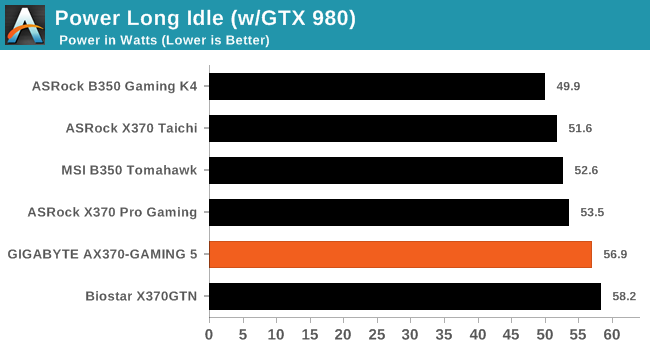
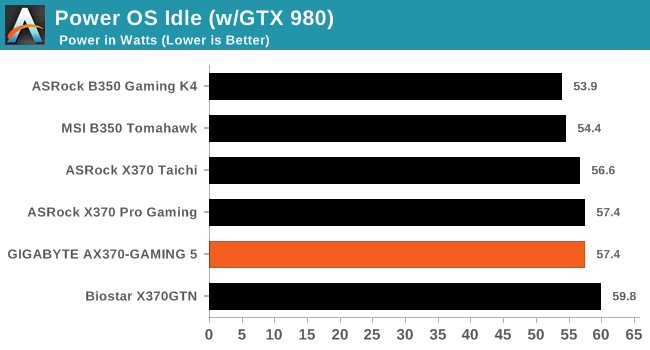
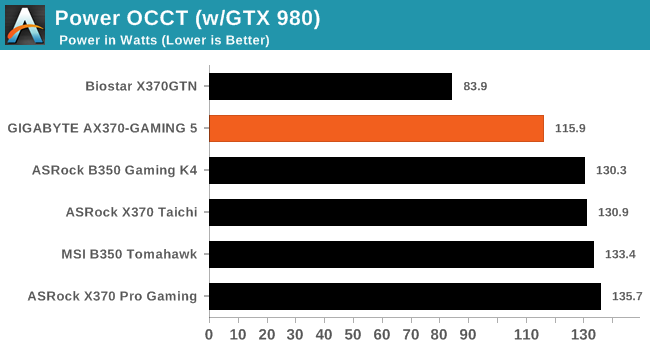
The idle power consumption numbers for the Gaming 5 were slightly higher than most of the boards, likely due to the use of dual network controllers and the additional USB 3.1 controller, not to mention all the LED lighting. That being said, under load, it used 15W less power than the other full-sized motherboards. We are still trying to narrow down exactly what is the cause, in case something isn't firing up properly. Nonetheless, nothing was untoward in our benchmarking.
Non-UEFI POST Time
Different motherboards have different POST sequences before an operating system is initialized. A lot of this is dependent on the board itself, and POST boot time is determined by the controllers on board (and the sequence of how those extras are organized). As part of our testing, we look at the POST Boot Time using a stopwatch. This is the time from pressing the ON button on the computer to when Windows starts loading. (We discount Windows loading as it is highly variable given Windows specific features.)
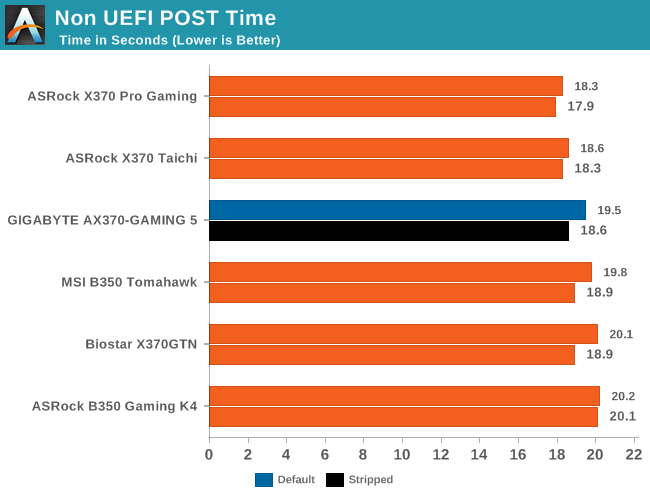
Most of the POST times on X370 seem to be in the same ball-park, differing by a second or two.
Rightmark Audio Analyzer 6.2.5
Rightmark:AA indicates how well the sound system is built and isolated from electrical interference (either internally or externally). For this test we connect the Line Out to the Line In using a short six inch 3.5mm to 3.5mm high-quality jack, turn the OS speaker volume to 100%, and run the Rightmark default test suite at 192 kHz, 24-bit. The OS is tuned to 192 kHz/24-bit input and output, and the Line-In volume is adjusted until we have the best RMAA value in the mini-pretest. We look specifically at the Dynamic Range of the audio codec used on the rear panel of the board.
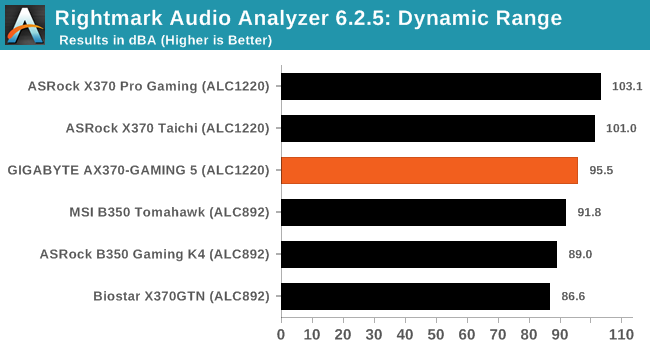
One of the downsides of using dual audio codecs is that the space that is normally dedicated for one now has to be split between two. The ALC1220 easily beats the ALC892 solutions, however.
DPC Latency
Deferred Procedure Call latency is a way in which Windows handles interrupt servicing. In order to wait for a processor to acknowledge the request, the system will queue all interrupt requests by priority. Critical interrupts will be handled as soon as possible, whereas lesser priority requests such as audio will be further down the line. If the audio device requires data, it will have to wait until the request is processed before the buffer is filled.
If the device drivers of higher priority components in a system are poorly implemented, this can cause delays in request scheduling and process time. This can lead to an empty audio buffer and characteristic audible pauses, pops and clicks. The DPC latency checker measures how much time is taken processing DPCs from driver invocation. The lower the value will result in better audio transfer at smaller buffer sizes. Results are measured in microseconds.
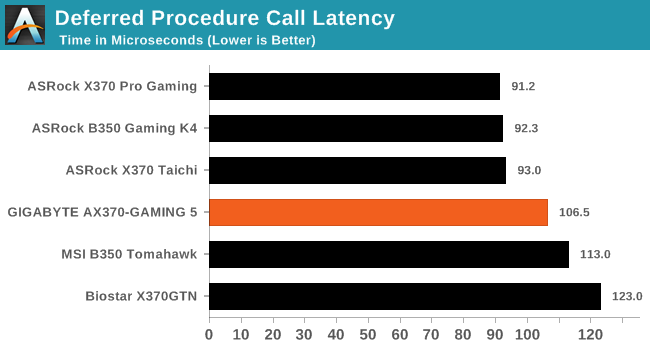
All of our X370 boards get under a nice 150 microseconds, although the ASRock boards seem to do well here. The Gaming 5 doesn't match them but is the next one behind.










34 Comments
View All Comments
The_Assimilator - Tuesday, November 14, 2017 - link
Seems like Gigabyte have run out of ideas to differentiate their boards from competitors, so now they're just slapping random junk on. "Oooh I know a second audio codec!"Why are there so few boards that don't waste money on "premium" audio? As someone who uses a USB headset, this has no value for me. Plus if I actually wanted actual premium audio, I'd pick up a discrete audio card anyway.
It really disappoints me that the motherboard industry has degenerated to the point of "great features/connectivity, great overclocking, no useless addons like LEDs: pick one".
Reginald Peebottom - Tuesday, November 14, 2017 - link
I agree the dual audio seems to be a pretty useless feature for the vast majority of users along with the killer NIC - I’d rather an Intel nic or even a Realtek and save the money.There’s a lot of motherboards that don’t use premium audio or NICs, if that’s what you want, but stand alone audio cards are much more of a rarity now along with stand alone NICs for home use.
Just get the B series chipsets.
The_Assimilator - Wednesday, November 15, 2017 - link
B350 has 4 fewer USB 3.0 (3.1 Gen1) ports, 2 fewer SATA ports, and 2 fewer PCIe 2.0 general-purpose lanes. It also misses out on SLI support and PCIe bifurcation. So not really an option.Seems like to get something decent I have to look at the HEDT market or "workstation" class boards, both of which carry a price premium for removing useless gimmicky crap that nobody wants or needs.
khanov - Tuesday, November 14, 2017 - link
It should be mentioned that this board has major incompatibility issues with a variety of expansion cards. Most SATA/SAS cards do not work, whether in IT or RAID mode, doesn't matter. Other common cards that don't work are some USB3.0 and 3.1 cards and some NICs. Pretty much anything with an option rom is unlikely to work in this motherboard and so far Gigabyte have been unwilling to address the issue.SRB181 - Tuesday, November 14, 2017 - link
Actually, it's worked with every Host bus adapter I've thrown at it. From scsi to fibre channel.If it's UEFI compatible, just let it boot. It takes the same time to initialize as if it loaded bios.
To use legacy cards, set the storage boot option control, or, other pci boot device option
to "legacy only" and they will load the card bios
JTDC - Tuesday, November 14, 2017 - link
Sorry to ask such an elementary question but can one of the two slots designated as being for graphics be used for other devices? Thanks.khanov - Tuesday, November 14, 2017 - link
Yes, you can use one slot for graphics with 8x lanes and the other for something else with up to 8x lanes. I just tested this with an intel NIC in the 2nd slot and it works. But you need to read my comment above. This board has compatibility issues with a lot of expansion cards, so depending on what you want to plug in, it might not work in any slot on this motherboard.I've confirmed that these cards DON'T work in this motherboard:
LSI 8888ELP SATA/SAS RAID card
3Ware 9650SE SATA RAID card
ASMedia 1061 2x SATA 3 card
Generic USB 3.0 2-port card
I'm willing to be a lot of other SATA/SAS card don't work either, but I don't have any more to test with.
SRB181 - Tuesday, November 14, 2017 - link
I don't think you have the bios set right. Have tested it with Adaptec ASR-5405z, ASR-6805t(both legacy and UEFI), both sas, IBM LPE 12002 Emulex Fiber channel and HP LPE 11002
cards (First UEFI, second legacy), and Adaptec 29329 LPE scsi card (legacy).
I ran a lot of these cards in the 1x slots with cable adapters to 16x and they worked fine
(just slower). About this time, I realized I could use more PCI-e lanes. Bought a Gigabyte x399
gaming 7 to use them with. Good luck
khanov - Wednesday, November 15, 2017 - link
I'm glad to hear that at least some storage adapters work with this board. I can confirm that the ones I listed do not work. I did of course have the two PCI device options (storage and other) on Legacy Only, and I've tried every other combo as well. The option roms of those cards I listed don't load in this board.I have been in contact with Gigabyte over this issue for more than a month, but they are unable (unwilling?) to fix it. I even offered to send them a spare 3Ware 9650SE but they were not interested.
They did confirm the issue with the ASMedia 1061 card and offered a partial fix that only works with motherboard SATA ports set to AHCI. I would say to anyone thinking of buying this board: Check with Gigabyte that your expansion cards will work first.
rsandru - Wednesday, November 15, 2017 - link
I own this board too and while I like it a lot, I can confirm Gigabyte support is complete garbage. I've been trying to have them resolve an SLI related problem since May, and gave up after several useless ticket exchanges with their support team. Next board will most certainly not be a Gigabyte...